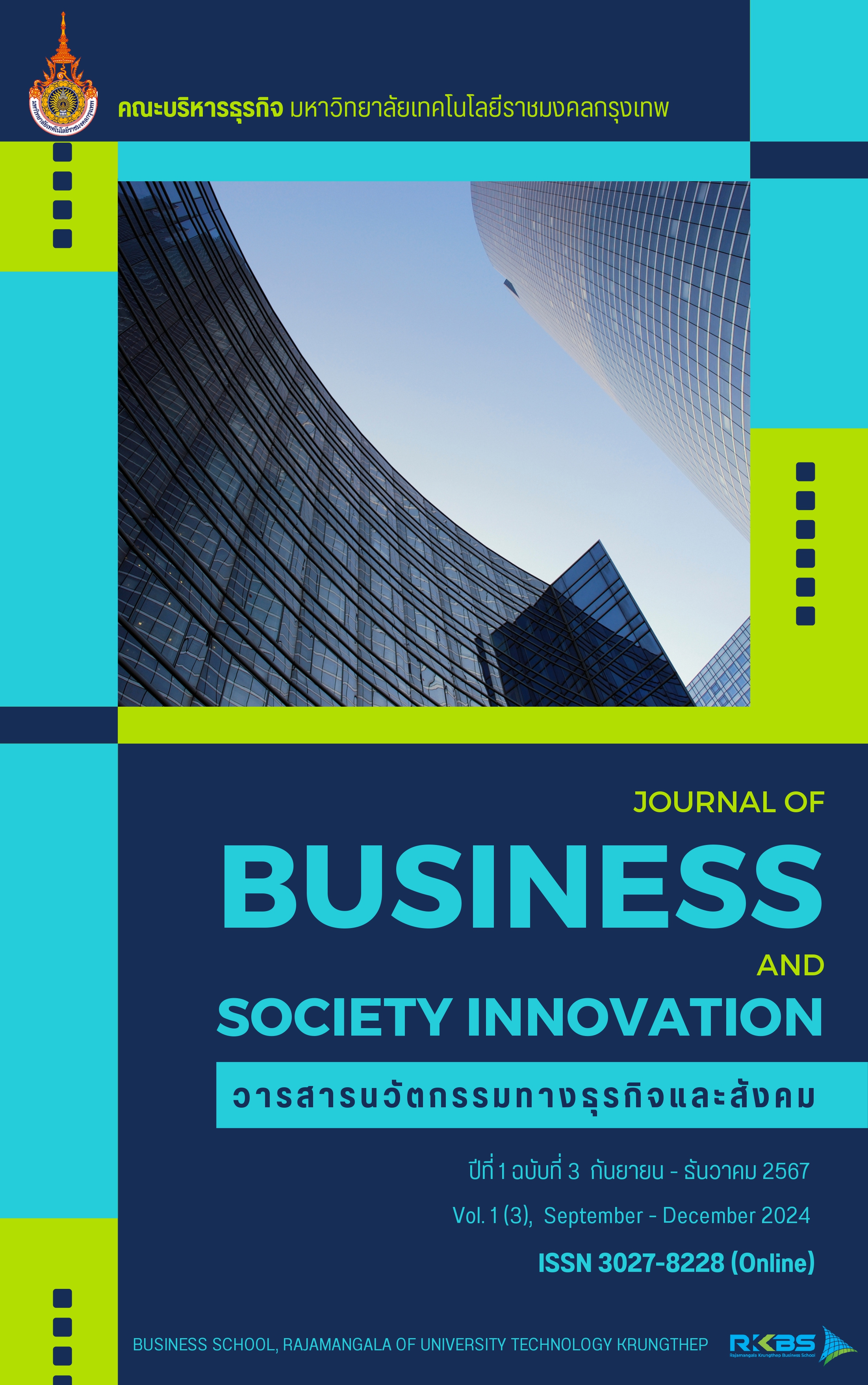การศึกษาเปรียบเทียบพฤติกรรม ทัศนคติ และความพึงพอใจของผู้บริโภคต่อการเลือกซื้ออุปกรณ์ไฟฟ้าช่องทางออนไลน์และช่องทางออฟไลน์ ในกรุงเทพมหานคร
คำสำคัญ:
พฤติกรรมผู้บริโภค ช่องทางออนไลน์ ช่องทางออฟไลน์ ความพึงพอใจบทคัดย่อ
การวิจัยครั้งนี้มีวัตถุประสงค์เพื่อศึกษาพฤติกรรม ทัศนคติ และความพึงพอใจของผู้บริโภคที่เลือกซื้ออุปกรณ์ไฟฟ้าผ่านช่องทางออนไลน์และออฟไลน์ในกรุงเทพมหานคร รวมถึงการเปรียบเทียบทัศนคติและความพึงพอใจต่อส่วนประสมทางการตลาดระหว่างสองช่องทางดังกล่าว กลุ่มประชากรเป้าหมายคือผู้บริโภคในกรุงเทพมหานครที่มีอายุ 18 ปีขึ้นไป และมีประสบการณ์ในการซื้ออุปกรณ์ไฟฟ้าผ่านทั้งสองช่องทาง จำนวน 400 คน โดยใช้การสุ่มตัวอย่างแบบสะดวกในการเก็บข้อมูล แบบสอบถามที่ใช้ในการวิจัยมีค่าดัชนีความสอดคล้อง (IOC) เท่ากับ 0.67 และค่าความเชื่อมั่นทั้งฉบับเท่ากับ 0.89 การวิเคราะห์ข้อมูลใช้สถิติเชิงพรรณนา เช่น ค่าเฉลี่ย และส่วนเบี่ยงเบนมาตรฐาน และสถิติเชิงอนุมาน เช่น การทดสอบทีแบบคู่ (Paired t-test) และการวิเคราะห์สัมประสิทธิ์สหสัมพันธ์แบบเพียร์สัน (Pearson's Correlation Coefficient) ผลการวิจัยพบว่า ผู้บริโภคมีพฤติกรรม ทัศนคติ และความพึงพอใจที่แตกต่างกันอย่างมีนัยสำคัญระหว่างการซื้ออุปกรณ์ไฟฟ้าผ่านช่องทางออนไลน์และออฟไลน์ โดยช่องทางออฟไลน์ได้รับการประเมินในเชิงบวกมากกว่าในทุกด้าน ผลการทดสอบสมมติฐานแสดงให้เห็นความแตกต่างอย่างมีนัยสำคัญทางสถิติ (p < .001) ในด้านพฤติกรรมการซื้อ (t = -8.734) ทัศนคติต่อส่วนประสมทางการตลาด (t = -12.456) และความพึงพอใจ (t = -10.218) ระหว่างช่องทางออนไลน์และออฟไลน์ นอกจากนี้ การวิเคราะห์ความสัมพันธ์พบว่า ทัศนคติต่อส่วนประสมทางการตลาดมีความสัมพันธ์เชิงบวกในระดับสูงกับความพึงพอใจ (r = 0.715, p < .01) ในขณะที่พฤติกรรมการซื้อมีความสัมพันธ์เชิงบวกในระดับปานกลางกับทัศนคติต่อส่วนประสมทางการตลาด (r = 0.587, p < .01) และความพึงพอใจ (r = 0.623, p < .01) ผลการวิจัยนี้สามารถนำไปใช้ในการพัฒนากลยุทธ์การตลาดแบบ Omni-Channel ที่เชื่อมโยงประสบการณ์การซื้อสินค้าผ่านทั้งสองช่องทางอย่างมีประสิทธิภาพ เพื่อเพิ่มความพึงพอใจและตอบสนองความต้องการของผู้บริโภค
References
กรุงเทพมหานคร. (2566). ข้อมูลเกี่ยวกับเขตการปกครองของกรุงเทพมหานคร. สืบค้นจาก http://www.bangkok.go.th.
เกรียง กิจบำรุงรัตน์. (2564). ปัจจัยที่มีอิทธิพลต่อการตัดสินใจซื้อสินค้าของผู้บริโภคทางสังคมออนไลน์. วารสารวิทยาศาสตร์และเทคโนโลยี มหาวิทยาลัยมหาสารคาม, 41(1), 18-28.
ชยุฒม์ ตั้งกมลสุวรรณ. (2565). ปัจจัยที่มีความสัมพันธ์ต่อการซื้อสินค้าออนไลน์ประเภทเครื่องใช้ในบ้านของผู้บริโภคในเขตกรุงเทพมหานคร. สารนิพนธ์ หลักสูตรบริหารธุรกิจมหาบัณฑิต, มหาวิทยาลัยศรีนครินทรวิโรฒ.
ณัฐยา พรหมรศ. (2565). การเปรียบเทียบพฤติกรรมการซื้อสินค้าอุปโภคบริโภคผ่านช่องทางร้านค้าปลีกสมัยใหม่ และร้านค้าออนไลน์ ช่วงก่อนและระหว่างภาวะวิกฤตโควิด-19. สารนิพนธ์ หลักสูตรปริญญาการจัดการมหาบัณฑิต, มหาวิทยาลัยมหิดล.
ทรงกลด วณิชเสถียร และพจนา ธูปแก้ว. (2566). พฤติกรรมการเลือกใช้บริการและปัจจัยส่วนประสมทางการตลาดที่ส่งผลต่อการตัดสินใจสั่งอาหารผ่านแอปพลิเคชันออนไลน์ของผู้บริโภค ในเขตกรุงเทพมหานคร. วารสารมหาจุฬานาครทรรศน์, 10(11), 209-221.
ธมลวรรณ สมพงศ์ . (2564). การศึกษาปัจจัยที่มีผลต่อการตัดสินใจซื้อสินค้าทางออนไลน์ของผู้บริโภคในจังหวัดนครปฐม. วิทยานิพนธ์ หลักสูตรวิศวกรรมศาสตรมหาบัณฑิต, มหาวิทยาลัยศิลปากร.
พิมพ์ชนก บุญอินทร์. (2564). การเปลี่ยนพฤติกรรมการซื้อสินค้าจากออฟไลน์ไปสู่ออนไลน์และความเสี่ยงที่เกี่ยวข้อง ของผู้บริโภคในธุรกิจค้าปลีก. สารนิพนธ์ หลักสูตรปริญญาการจัดการมหาบัณฑิต วิทยาลัยการจัดการ มหาวิทยาลัยมหิดล.
ภัทราภรณ์ ปัญโญใหญ่. (2565). อิทธิพลของการตลาดแบบไร้รอยต่อ (Omni Channel Marketing) ที่ส่งผลต่อความภักดีของลูกค้าร้าน UNIQLO ในจังหวัดเชียงใหม่. การค้นคว้าอิสระ หลักสูตรปริญญาบริหารธุรกิจมหาบัณฑิต มหาวิทยาลัยแม่โจ้.
สำเภา มีบุญ และเสาวนีย์ สมันต์ตรีพร. (2566). ความเชื่อมั่นของผู้ซื้อสินค้าและพฤติกรรมผู้บริโภคที่ส่งผลต่อการตัดสินใจซื้อสินค้าออนไลน์ของวัยทำงาน ในกรุงเทพมหานคร. Journal of Modern Learning Development, 8(1), 211-225.
Babbie, E. (2020). The Practice of Social Research (15th ed.). Cengage Learning.
Cochran, W. G. (1977). Sampling Techniques (3rd ed.). John Wiley & Sons.
DeVellis, R. F. (2016). Scale Development: Theory and Applications (4th ed.). Sage Publications.
Field, A. (2017). Discovering Statistics Using IBM SPSS Statistics (5th ed.). Sage Publications.
Fowler, F. J. (2013). Survey Research Methods (5th ed.). Sage Publications.
Hair, J. F., Black, W. C., Babin, B. J., & Anderson, R. E. (2019). Multivariate Data Analysis (8th ed.). Cengage Learning.
Howell, D. C. (2012). Statistical Methods for Psychology (8th ed.). Cengage Learning.
Levy, P. S., & Lemeshow, S. (2013). Sampling of populations: Methods and applications (4th ed.). John Wiley & Sons.
Nunnally, J. C. (1978). Psychometric Theory (2nd ed.). McGraw-Hill.
Rovinelli, R. J., & Hambleton, R. K. (1977). On the use of content specialists in the assessment of criterion-referenced test item validity. Dutch Journal of Educational Research, 2, 49-60.
Additional Files
เผยแพร่แล้ว
How to Cite
ฉบับ
บท
License
Copyright (c) 2024 วารสารนวัตกรรมทางธุรกิจและสังคม

This work is licensed under a Creative Commons Attribution-NonCommercial-NoDerivatives 4.0 International License.

